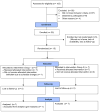An innovative acupuncture treatment for primary dysmenorrhea: a randomized, crossover pilot study
- PMID: 24445356
- PMCID: PMC3898591
An innovative acupuncture treatment for primary dysmenorrhea: a randomized, crossover pilot study
Abstract
Context: Dysmenorrhea, the occurrence of painful menstrual cramping of the uterus, is a major cause of activity restriction and absences from school and work among young women. Standard pharmaceuticals used to treat dysmenorrhea are not effective for all women and have side effects that limit their use. Studies elsewhere have shown beneficial effects for use of vitamin K1 as an acupoint treatment, but the acceptability of this treatment to women in the United States has been unknown.
Objective: The study intended to examine the feasibility, acceptability, and preliminary effects of acupuncture point injection of vitamin K1 as an alternative treatment for primary dysmenorrhea among US women.
Design: The research team conducted a pilot study using a blinded, randomized, crossover trial design.
Setting: The study took place at the University of California, San Francisco (UCSF).
Participants: The study was conducted in the San Francisco Bay Area among women 18 to 25 y of age who had been diagnosed with primary dysmenorrhea. Fourteen women completed all of the study's visits.
Intervention: Women with primary dysmenorrhea were randomized into 2 groups to receive bilateral injections of vitamin K1 in the Spleen-6 (SP-6) acupuncture point at the start of menstruation and then, following a 2-mo washout period, saline in a nonacupuncture point at the start of menstruation. One group received the vitamin K1 injection first, while the other group received the saline injection first.
Outcome measure: Dysmenorrhea pain intensity was measured using a 0-10 numeric rating scale (NRS), before and after injections.
Results: Women had an average 2.5-point decrease in pain after a vitamin K1 injection in the SP-6 acupoint (P < .001), as compared with a 1.8-point decrease after a saline injection (P < .001). Change scores for vitamin K1, as compared with a saline injection, approached statistical significance (P < .10). Intensity and duration of menstrual symptoms, as measured by the Cox retrospective symptom scale, also decreased following injections. After participating, 94% of the women remained agreeable to receiving the injection therapy, and 77% reported they would come every month were the treatment available.
Conclusions: Findings suggested high acceptability for an acupuncture point injection of vitamin K1 as treatment for primary dysmenorrhea among young women in San Francisco. Pain decreased with both treatments, with a trend toward greater pain reduction for the vitamin K1/SP-6 injection. This finding is consistent with outcomes from the Obstetrics and Gynecology Hospital in Shanghai, China, where the protocol was developed.
Figures
References
-
- Harlow SD, Park M. A longitudinal study of risk factors for the occurrence, duration and severity of menstrual cramps in a cohort of college women. Br J Obstet Gynaecol. 1996;103(11):1134–1142. - PubMed
-
- Klein JR, Litt IF. Epidemiology of adolescent dysmenorrhea. Pediatrics. 1981;68(5):661–664. - PubMed
-
- Johnson J. Level of knowledge among adolescent girls regarding effective treatment for dysmenorrhea. J Adolesc Health Care. 1988;9(5):398–402. - PubMed
-
- Dawood MY. Dysmenorrhea. Clin Obstet Gynecol. 1990;33(1):168–178. - PubMed
Publication types
MeSH terms
Substances
Grants and funding
LinkOut - more resources
Full Text Sources
Medical


